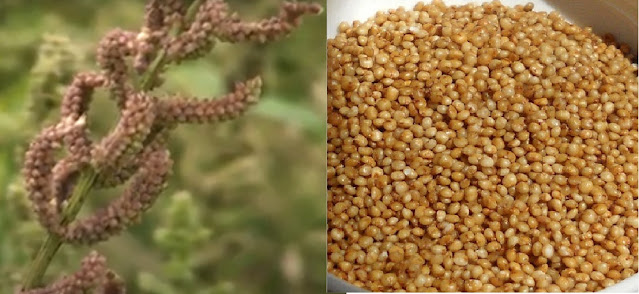Barnyard Millet or Sawan Cultivation in India
Barnyard millet or Sawan Cultivation in India
Sawan or Barnyard millet (Echinochloa frumentacea L.) is an herbaceous annual plant that tillers sparsely. This plant grows up to a height of 60 to 120 centimeter It is a grain crop of lesser importance. It is a highly drought-resistant crop but is also capable of withstanding waterlogging conditions. It is generally grown as a rainfed crop. Sawan grains are consumed just like rice. Barnyard millet is also used in making rice pudding (kheer).
In India, it is grown in states like Madhya Pradesh, Uttar Pradesh, Tamil Nadu, Andhra Pradesh, Karnataka, Maharashtra, and Bihar.
Vernacular Names of Barnyard Millet or Sawan ;
English ; Barnyard Millet
Hindi; Sanwa, Jhangon
Sanskrit; Shyama
Kannada; Oodalu
Tamil; Kuthiravaali
Malayalam; Panivaragu
Marathi; Shamul
Gujarati; Sama
Bengali; Shamula
Punjabi; Swank
Nutritive Value of Barnyard millet or Sawan;
|
Nutrient |
Value |
Nutrient |
Value |
|
Protein |
11 g |
Calcium |
22 mg |
|
Fat |
3.9 g |
Iron |
18.6 mg |
|
Crude Fiber |
13.6 g |
Thiamin |
0,33 mg |
|
Carbohydrates |
55 g |
Riboflavin |
0.10 mg |
|
Energy |
300 kcal |
Niacin |
4.2 mg |
Health Benefits Barnyard millet or Sawan
 |
| Sawa (Barnyard Millet.) Dosa Credit; CCO Public Domain Flickr |
1) Rich in Fiber; It is a good source of dietary fiber its grain contains the highest amount of fiber in contrast to other grains and millets.
2) Low in Calories; Barnyard millet is a good source of highly digestible protein and low in calories
4) Good Source of Iron
5) Low Glycemic Index: The carbohydrate content of barnyard millet (Sawan) is low and its slow-digesting process, making the barnyard millet a low glycemic index food. therefore, it can be recommended for patients with cardiac disease and diabetes
Climatic Requirements for Barnyard millet or Sawan Crop;
1) Barnyard or Sawan millet is a drought-tolerant crop and hence is grown as a rainfed crop.
Soil Requirements for Barnyard millet or Sawan Crop;
1) Sawan is generally cultivated in soils of marginal fertility.
Important Varieties Barnyard millet or Sawan Crop
|
State |
Varieties released/ recommended |
Varieties popular in the State |
|
Bihar |
VL-Madira-181 and VL-Madira-2007. |
|
|
Gujarat |
VL-Madira-172 |
|
|
Jharkhand |
VL-Madira-181 and VL-Madira-2007. |
|
|
Karnataka |
VL-Madira-172, VL-Madira-181 and VL-Madira-2007. |
VLM-181, VLM-172 and VLM-29. |
|
MP |
VL-Madira-181. |
|
|
Rajasthan |
Pratap sanwa-1 and VL-Madira-2007. |
|
|
Tamilnadu |
VL-Madira-181 |
CO-1, K-1 and K-2. |
|
UP |
Kanchan and VL-Madira-172 |
|
|
Uttrakhand |
Kanchan, VL-Madira-172, VL-Madira-2007 and PRJ-1 |
VLM-172, VLM-29, VLM-2007 and PRJ-1. |
Rotations and Mixed Cropping in Barnyard millet or Sawan Crop;
Sawan-gram
2) It is also grown mixed with cotton, pigeon pea, or other short-duration pulses.
Field Preparation for Barnyard Millet or Sawan Crop
Since it is cultivated in very light and marginal soils, the land is given only limited preparatory cultivation. Two ploughings with a local plough or harrowing followed by planking are sufficient to prepare the seedbed for sawan.
Seed and Sowing for Barnyard millet or Sawan Crop
1) Sawan can be sown in the first fortnight of July with the onset of monsoon rains.
Manures and Fertilisers Requirement in Barnyard millet or Sawan Crop;
1) Farm Yard manure or compost at the rate of 5 to 10 tonnes per hectare should be added for boosting the yield.
Water Management in Barnyard millet or Sawan Crop;
Generally, Sawan does not require any irrigation. However, if a dry spell prevails for a long period, then one irrigation must be given at the time of the panicle initiation stage. It is always better if excess water from heavy rains is drained out of the field.
Weed Control in Barnyard millet or Sawan Crop;
1) The field should be kept weed-free up to 25-30 days after sowing.
Diseases and Pest Management in Barnyard Millet or Sawan Crop ;
a) Disease Management ;
2) Smut
It is also caused by a fungus. The affected panicles are full of black masses instead of grains.
3) Rust
It is caused by a fungus. Black spots are seen in lines on leaves. It causes a considerable reduction in grain yield.
Insect Pests Management ;
Termites and stem borers are important pests of this crop. Termites can be controlled by using 5% Aldrin or Heptachlor dust at the rate of 15-20 kg per hectare before sowing. It should be mixed properly in the soil. Stem borer can be controlled by applying 15 kg Thimet granules per hectare.




